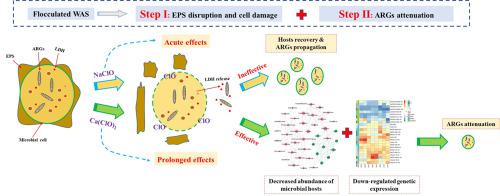Journal of Hazardous Materials ( IF 12.2 ) Pub Date : 2020-09-17 , DOI: 10.1016/j.jhazmat.2020.124010 Jingyang Luo , Wenxuan Huang , Qin Zhang , Yang Wu , Fang Fang , Jiashun Cao , Yinglong Su

|
The effectiveness of hypochlorites (NaClO and Ca(ClO)2) on the reduction of antibiotic resistance genes (ARGs) during waste activated sludge (WAS) fermentation was determined by the quantitative PCR. NaClO and Ca(ClO)2 exhibited distinct effects on ARGs fates. Ca(ClO)2 was effective in removing all investigated ARGs, and the efficiency was highly dose-dependent. Unexpectedly, the NaClO treatment attenuated ARGs with lower efficiency and even caused the propagation of certain ARGs (i.e., aadA1 and tetQ) at higher doses. The extracellular polymeric substances dissolution and membrane integrity suggested that unstable NaClO had acute effects on bacteria initially, while it was ineffective to further attenuate ARGs released from hosts due to the rapid consumption of oxidative ClO-. Without lasting and strong oxidative stress, the microbial activities of tolerant ARGs hosts will partially recover and then contribute to the ARGs dissemination across genera. In contrast, solid-state Ca(ClO)2 was slowly released and exhibited prolonged effects on bacteria by disrupting cell membranes and removing the susceptible ARGs released from hosts. Furthermore, bacterial taxa-ARG network analysis indicated that Ca(ClO)2 reduced the abundance of potential hosts, and the metabolic pathway and gene expression related to ARGs propagation were significantly downregulated by Ca(ClO)2, which contributed to efficient ARGs attenuation.
中文翻译:

次氯酸盐类型对废物活化污泥发酵过程中抗生素抗性基因减少的不同影响:细菌群落,细胞活性和基因表达的见解
通过定量PCR确定了次氯酸盐(NaClO和Ca(ClO)2)在废物活性污泥(WAS)发酵过程中减少抗生素抗性基因(ARGs)的有效性。NaClO和Ca(ClO)2对ARG的命运表现出明显的影响。Ca(ClO)2可有效去除所有研究的ARGs,且效率高度依赖于剂量。出乎意料的是,治疗的NaClO减毒的ARG具有较低效率,甚至引起某些ARG游戏的传播(即,AAD A1和TETQ)高剂量。该胞外聚合物的溶解和膜的完整性建议不稳定的次氯酸钠对急性细菌最初效果,而这是无效的,从主机的发布进一步削弱的ARG由于氧化CLO的快速消耗- 。如果没有持久的强氧化应激,耐受性ARGs宿主的微生物活性将部分恢复,然后有助于ARGs在整个属中的传播。相反,固态Ca(ClO)2缓慢释放,通过破坏细胞膜并去除宿主释放的敏感ARGs,对细菌表现出延长的作用。此外,细菌类群-ARG网络分析表明,Ca(ClO)2Ca(ClO)2显着下调了潜在宿主的丰度,并且与ARGs繁殖相关的代谢途径和基因表达被Ca(ClO)2显着下调,这有助于有效的ARGs衰减。









































 京公网安备 11010802027423号
京公网安备 11010802027423号